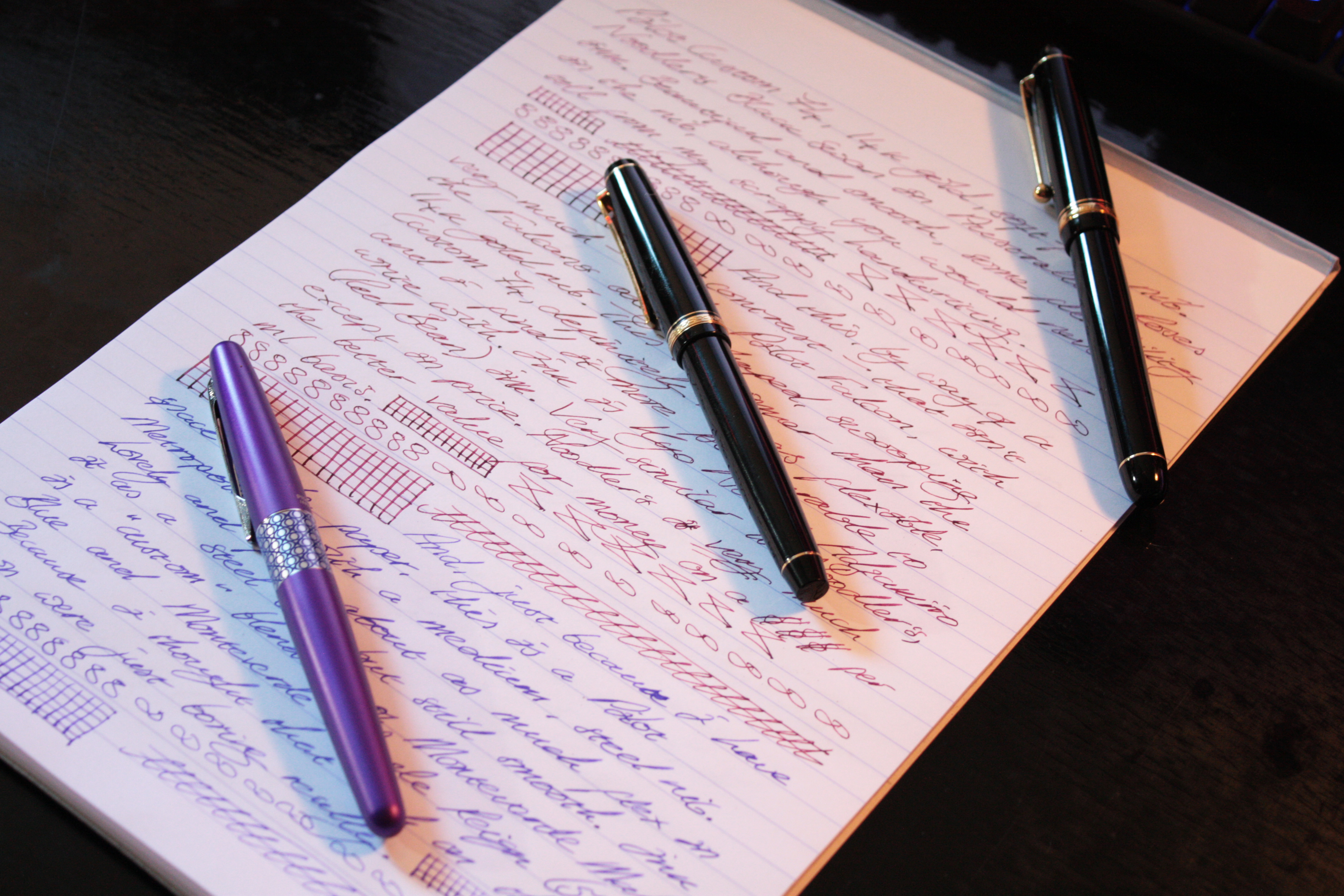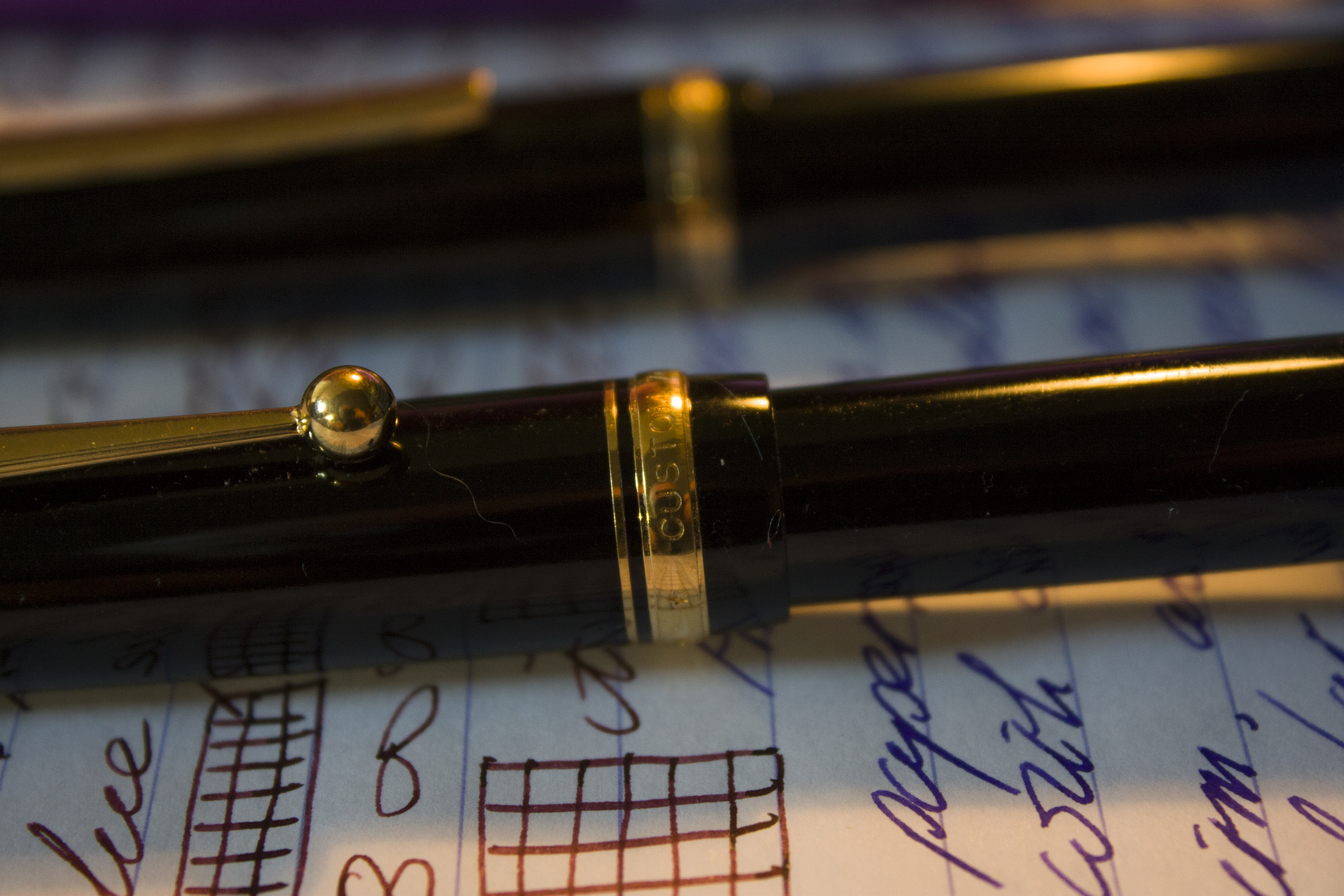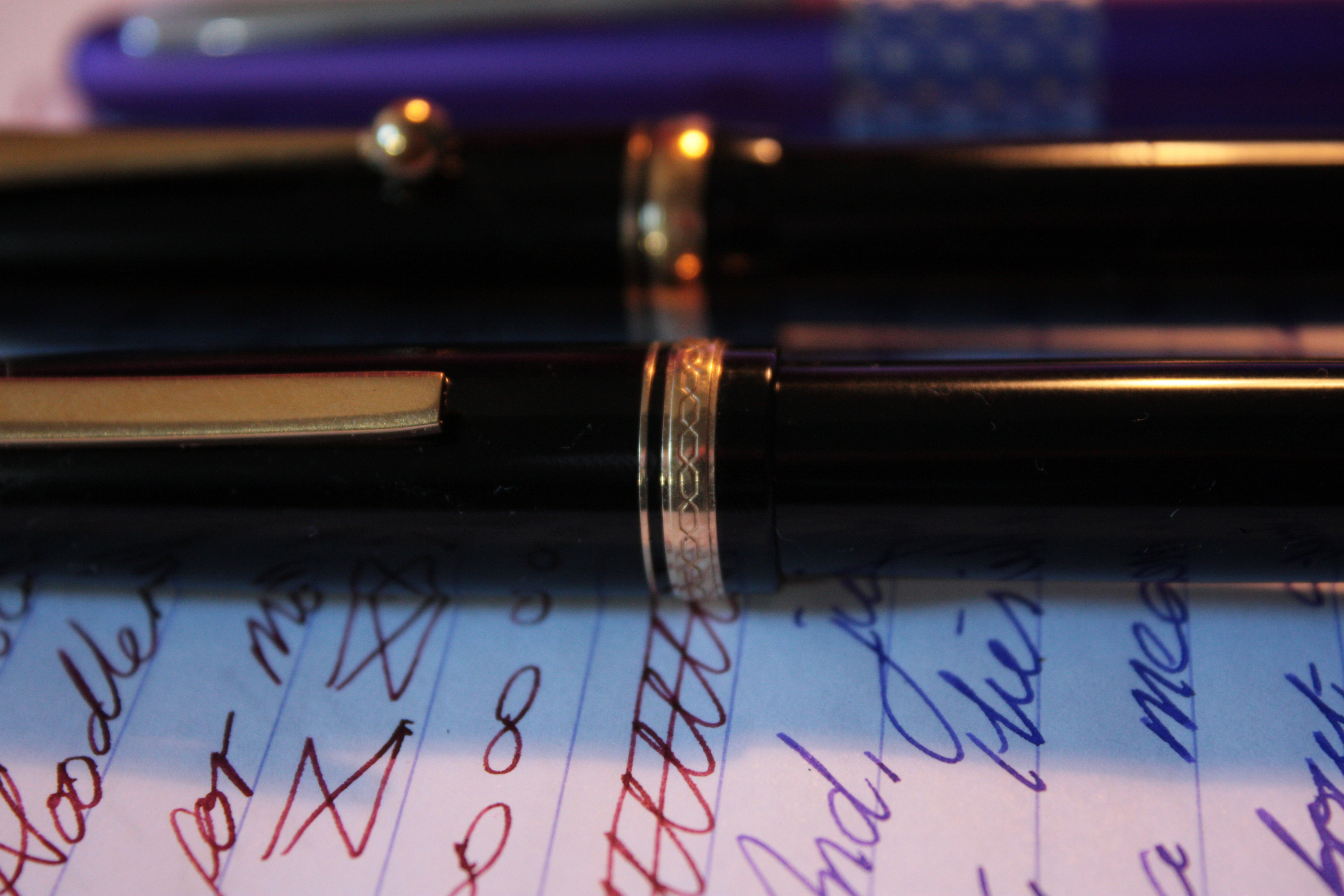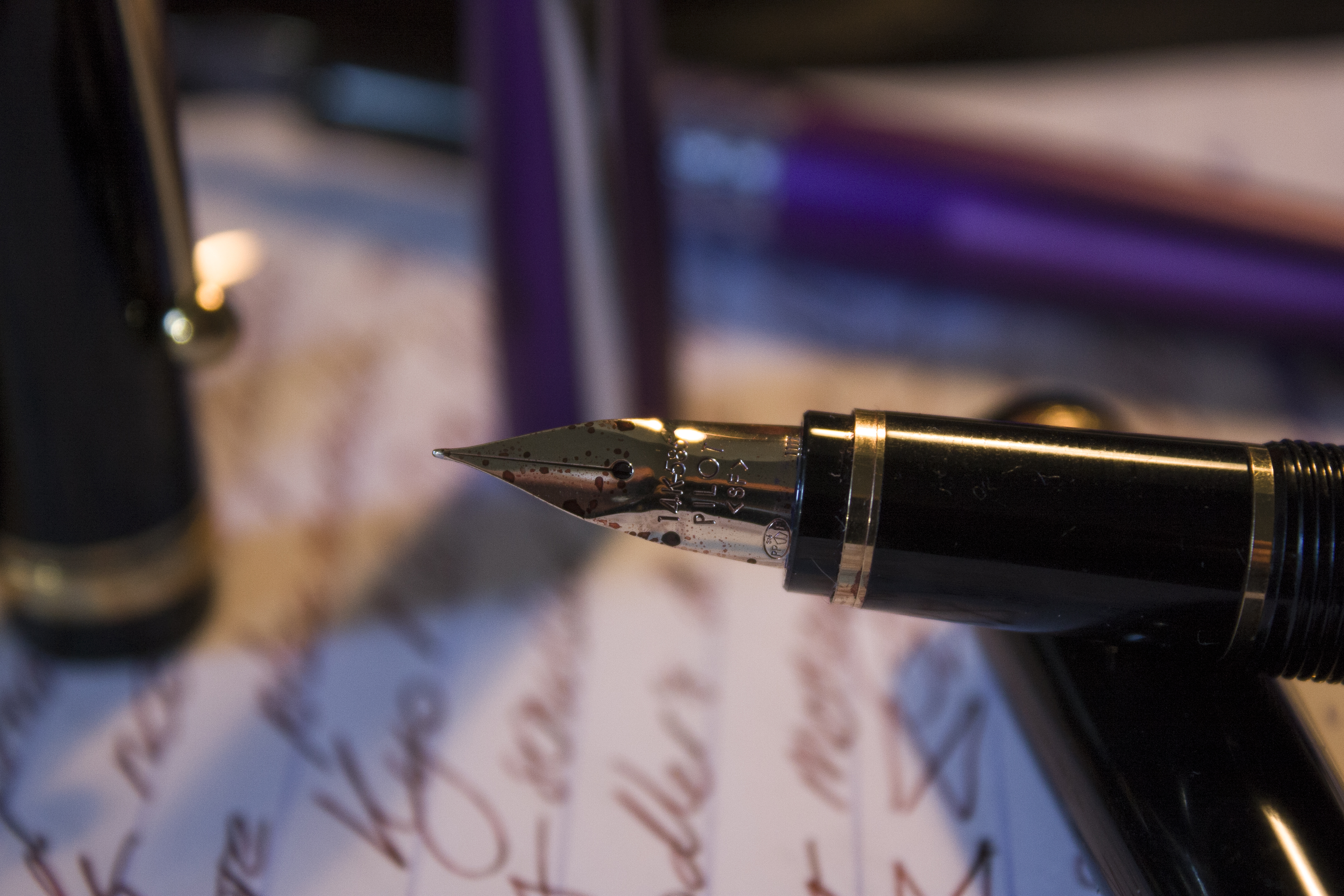 I have had a few Pilot pens in my collection over the years, including a much loved Custom 823. Tragically, the 823 was stolen during the after-hours of an academic conference some years ago, whilst I was attempting to prove the hypothesis that a yard of Young’s Winter Warmer could indeed be consumed in less than 30 seconds—don’t ask, it was not my finest moment, and I still maintain it can be done, though not by me*. Strangely, I’ve never replaced the 823, though it was a lovely pen. These days, I have an array of Metropolitans in colors which match my favorite inks, and two others which are daily essentials—the Falcon (known years ago as the Namiki Falcon), and the Custom 74 (the cartridge/converter version of the more expensive Custom 92). Both my Falcon, and the Custom 74 have nominally the same nibs, they’re both 14K gold and soft-fine (SF), but therein the similarities begin pining for the Fjords. Those of you not familiar with what may be the most famous Monty Python sketch of all time (bow your heads in shame), just turn your sound on and click the link, you’ll get the idea.
I have had a few Pilot pens in my collection over the years, including a much loved Custom 823. Tragically, the 823 was stolen during the after-hours of an academic conference some years ago, whilst I was attempting to prove the hypothesis that a yard of Young’s Winter Warmer could indeed be consumed in less than 30 seconds—don’t ask, it was not my finest moment, and I still maintain it can be done, though not by me*. Strangely, I’ve never replaced the 823, though it was a lovely pen. These days, I have an array of Metropolitans in colors which match my favorite inks, and two others which are daily essentials—the Falcon (known years ago as the Namiki Falcon), and the Custom 74 (the cartridge/converter version of the more expensive Custom 92). Both my Falcon, and the Custom 74 have nominally the same nibs, they’re both 14K gold and soft-fine (SF), but therein the similarities begin pining for the Fjords. Those of you not familiar with what may be the most famous Monty Python sketch of all time (bow your heads in shame), just turn your sound on and click the link, you’ll get the idea.
I purchased each of these pens, at one time or another, with my own addiction-dwindled-funds from the wondrous Wonder Pens…
 Jon and Liz
Jon and Liz
Wonder Pens
52 Clinton Street, Toronto, Ontario M6G 2Y3. Canada
Phone: (416) 799 5935
General Email: info@wonderpens.ca
Online Order Email: orders@wonderpens.ca
They are now most definitely not the only resource for online fountain pen purchases in Ontario, but I have to say—entirely independently—that after spending a lot of hours online, looking for the best buys, selection, and service, they are still very much my number one choice for the majority of my purchases.
Anyway, I thought it was about time that I plucked my favorite Pilots out of the pen case, and had a look at what has made them a part of my essential carry over time.
Oh yeah, and I threw in a Pilot Metropolitan Retro Pop Purple with a medium steel nib, because I had room at the bottom of the Clairefontaine Triomphe (90gsm, white, lined) A4 paper, that I used for the writing sample/s; and of course, because it’s a great pen. Trust me, the paper really was a nice crisp white, it’s just my poor lighting and lousy photographic skills that make it look a weird shade of off-lilac. Or maybe it’s just my eyes.
As I’m writing this post (August 2019), the Custom 74 and the Falcon are available at $230 and $235 CAD respectively, from Wonder Pens, and the Metropolitan is a bargain at about $30 CAD. I have reviewed the Metropolitan before, so I won’t be going into depth about it here, but I thought it was worth including in the writing samples, in order to give a comparison of Pilot’s soft-fine versus medium nib classifications. Or at least I thought it was interesting, pen nerd that I am.
 I like the size of both of these pens, they sit in my large hands comfortably, and are very well balanced with or without posting (which I never usually do). And looking at the comparison graphic above, they compare very favorably with other models in the same price bracket.
I like the size of both of these pens, they sit in my large hands comfortably, and are very well balanced with or without posting (which I never usually do). And looking at the comparison graphic above, they compare very favorably with other models in the same price bracket.
From left to right (above), we have the Custom 74, with its rounded cap and finial; the Falcon, with the flat cap and finial; and the Metropolitan, the only one of the three with a rounded push-on (instead of threaded) cap.
All three pens are cartridge/converter fillers, and there are interesting differences even with such a common filling mechanism. The Custom 74 can support Pilot’s hi-capacity Con-70 converter (a somewhat pricey $27 CAD from Wonder Pens). The pen isn’t supplied with this model of converter, but I thoroughly recommend picking one up if you’re buying the pen. The Falcon is supplied with Pilot’s standard Con-40 converter (a much more agreeable $8.50 CAD), which can also be used by the Metropolitan. However, the Metropolitan, is fitted with Pilot’s squeezy converter. This is a sort of bladder-like device, which never really gathers up much ink. All the same, I find this converter incredibly easy to clean, and thus it makes for a very convenient pen to fill with a little ink for a specific project, then clean and leave to dry between uses (e.g., for testing inks on different paper).
In contrast to many other pen manufacturers like Sailor, Platinum, Pelikan, and even the likes of TWSBI, who tend to standardize designs across the range, Pilot’s clips and cap bands are completely different between the Custom 74 and the Falcon.
The Custom 74 shares the same clip and cap band design as the Custom 92 and 823. The clip is inscribed with the Pilot brand name near the top of the cap, and terminates with a round ball at the bottom. The cap band reads Pilot Made in Japan Custom 74 (or the alternative appropriate model for either the 92 or 823).
The Falcon however, has a straight-edged, flat clip, with no branding, and a cap band which reads Pilot Japan amidst a pattern of links around the band. Overall, the Falcon has a more angular design from the finial to the top of the cap—not to mention the nib… which I won’t, not until I get to it in a line or two.
And, of course, the budget-conscious Metropolitan is different yet again.
The Nibs
The angular design of course, includes the famous, swooping, predatory beak of the Falcon…
Which, I have to admit, is an acquired taste; it looks a little odd at first, but I’ve found its appeal definitely grows over time and use.
The Custom 74 on the other hand, is about as conventional to look at as a 14K gold nib gets, but again, this is where the two differ from most norms.
They may both be called soft-fine, but some soft-fine nibs are more soft-fine than others.
So What Do They Write Like?
 This scan compares my (awful) handwriting, as produced by each of the pens I’ve been looking at; the top two are the Custom 74 and Falcon, 14K soft-fine nibs. The Custom 74 was—even to me, and I don’t really vary the weight of my touch when writing—obviously more flexible than that of the Falcon.
This scan compares my (awful) handwriting, as produced by each of the pens I’ve been looking at; the top two are the Custom 74 and Falcon, 14K soft-fine nibs. The Custom 74 was—even to me, and I don’t really vary the weight of my touch when writing—obviously more flexible than that of the Falcon.
I should note that neither pen is strictly a flexible nib, so don’t push those tines too far if you ever use one of these pens, but they do offer a degree of flexibility beyond the norm (whatever you may define that as). Both pens exhibited a considerable degree of flexibility and thus line variation when pushed, but that swooping falcon nib was noticeably firmer than the Custom 74.
The Metropolitan’s medium steel nib however, was about as flexible as a pick-axe. Don’t get me wrong, it was as pick-axe-like as a pick-axe that had spent hours being smoothed by The Seven Dwarves, and hand polished by Snow-White, but only a magic fairy or two could ever make it flexible.
Writing with each nib is therefore an exercise in contrasting similarities. They’re all beautifully smooth, but…
… the Custom 74 would suit somebody who can naturally vary the heft of their hand as they write, and can get the most out of that—almost, but not quite—semi-flexible nib; whereas…
… the Pilot Falcon suits me better. I like the springiness of the soft-fine Falcon nib, but it’s firm enough that I don’t worry about springing the tines, the way I do—a little—with the Custom 74. Whilst…
… the Pilot Metropolitan is the proletariat of the fountain pen world, the daily worker that doesn’t cost much in the great scheme of things, but can always be relied upon to get the job done.
NB. Okay, I’ve given enough hints, how many of you can name where the last three writing samples came from (without Googling the quotations)? And who’s going to be first?
Summary
The Pilot Custom 74 never seems to get much love in the fountain pen world. People always seem to recommend the piston-filling Custom 92 for the ink capacity; and other than that, they’re the same pen. Yet with the Con-70 converter installed, I think you can strike a great compromise between the convenience of cartridge/converter filling, and the capacity of filling an ink chamber directly from a bottle. That sort of compromise is a major pro for me; I have used both the 74 and the 92 over time, and I bought a Custom 74, not a 92.
The Falcon is a different matter. It’s a quirky pen to look at and to use. I know some people that just can’t seem to write with that nib at all, and are put off by its bird-of-prey profile; I love it, on both counts. And then there’s the Metropolitan, is there anything new to say about the Pilot Metropolitan? This is a great little work-horse of a pen; inexpensive; easy to clean; available in a huge variety of nib sizes (including an italicized stub); and a color range that can match almost any ink you can throw in it. I may never have met a Sailor I didn’t like, but I quite fancy a Pilot or two too.
PS. If you ever read this blog, I know you stole my 823, and I have a vague idea of who you are. If you return my pen unharmed, that’ll be the end of it. I will not look for you, I will not pursue you. But if you don’t, I will look for you, I probably won’t find you, but I might, and if I do, I will seriously embarrass you, or maybe myself.
My apologies to Liam Neeson. He didn’t steal my pen… unless he was in the bar; I may not have noticed.
* This is such a bad idea on so many levels, beginning with your shirt, half-drowning in perfectly good beer, and quite possibly ending in kidney failure.















I did a review of the Custom 74 where I basically concluded it was a tremendous choice for a move-up, or first gold-nib, pen, which would suit almost anyone. So I agree that it is odd that more people don’t rave about it online. The only thing is, it seemed to me that had I bought the Custom 74 as my move-up pen, I might have stopped there. Perhaps that explains the lack of chatter? It’s not quirky or interesting, just a great “user” pen that would satisfy all your regular needs. So maybe people who buy the Custom 74 … just need that one “nice” pen?
Oh to have been that sensible. 🙂
On the other hand, I think my tastes in pens and nibs are almost opposite to yours, so I’d have ended up with a different Custom 74. That’s a fun game to play. I like the normal or “hard” Pilot fine nib. I also like the fun, colorful plastic “demonstrator” Custom 74s that are sold in the North American market. So I would have ended up with the blue, smoke or clear 74 with fine nib. 🙂
LikeLiked by 2 people
You’re absolutely right, and yes, your review (here) is one of the few I managed to find. And you’re spot on, on all points, you did a great review of the orange demonstrator and even then said you’d have preferred something more entertaining, and I bought the classic boring old fart black and gold 🙂
My daughter calls it fat old white man syndrome, usually just before I push her into the lake 🙂
LikeLiked by 1 person
Aw, it’s just what you like, that’s all. There are a lot of “old white men” with great taste in fun and colorful pens. 🤣 You like what you like! I support that.
LikeLiked by 1 person
Did everybody see how she omitted the f word? Thank you, as my old nan would have said (in a semi-East-End-of-London-accent), “That shows a bit of class that does.”
LikeLiked by 1 person
1984?
LikeLiked by 1 person
1984–Absolutely… endless thanks to my (then) much under-appreciated, English Literature teacher (Pauline Byrne), a lefty Scot, who got us all reading Orwell when I was about twelve. I would so like to take that lady for a beer or two now.
LikeLike
Orwell is great for teenagers (and adults). I have never read 1984, but I am a former bookseller and have some professional experience producing book titles from random bits of information. (*cracks knuckles* *looks pleased with self*)
LikeLiked by 1 person
Ah, you should read it, the Ministry of Truth is alive and holding regular press conferences.
LikeLike
I know I should. I’ve read his essays and some of his other novels. Also my real last name* appears in the book, which I rarely see in literature especially of that time.
*which happens not to be Clause
LikeLiked by 1 person
So you have to read it if it has a personal touch!
LikeLike
Also, if you were really Clause, your husband would have to have changed his name to Santa.
I am so sorry. I had to say it. It just had to be said. It’s been gnawing at me ever since you wrote that. I can get some sleep now.
LikeLike
Great post. Thank you!
Re the Winter Warmer, just because you can doesn’t mean you should! It’s bad enough by the pint. A yard of it is just taking masochism to the extreme.
I’ve never tried the Custom 74, and out of all the options you mention, the only one I could bring myself to buy would be the Custom 92. I hate Pilot converters with a passion! I don’t know who the person at Pilot was that thought the Con-70 was a good idea. They should be ashamed. I have no problem with the notion of proprietary converters, but this is a truly dreadful device. I’ve given up trying to get the residue of some ink out from behind the piston on mine. Because of it, my Custom 91 (with a soft fine nib) has been in the naughty corner of my pen pot for more than a year and I don’t see that changing anytime soon…
LikeLiked by 1 person
I know what you mean, the Con-70 can be finicky, but I suppose I’ve been lucky with the inks I’ve used, plus, I tend to keep two or three converters for each pen… one for blacks, one for reds & browns, one for blues. That way a bit of staining doesn’t bother me too much: it gets pricey when the converter is thirty bucks a time though 😦
LikeLiked by 1 person
Fair point. At least in the UK, the Con-70 costs around £12. Based on current exchange rates, you’re paying around 50% more! I seem to recall we’ve had a previous ‘conversation’ about Pilot’s North American pricing. They don’t seem to want to make it easy!
LikeLiked by 1 person
Pilot, Pelikan… there are probably more, and I’ll bet my next pen purchase that the BIG differences that crop up occasionally just cannot be justified by distributors and shipping costs (i.e., somebody along the line is making a disproportionate amount out of each unit in comparison to others in the chain). Such is capitalism, maybe I should try Cuba for my retirement. Hate to think what the cost of a classy fountain pen would be over there 😫
LikeLiked by 1 person
It may be capitalism, but it’s still downright odd behaviour. Yes, they need to turn a profit, but to do so they also need to sell product. If it’s cheaper to source a pen from overseas (factoring in exchange rates, import charges etc.) then that completely undermines local distributor arrangements and sales. I guess it makes sense to someone somewhere!
LikeLiked by 1 person
Yep. My guess is that the current pricing works, because only a minority want to ship from abroad—with all the warranty difficulties, and charges etc—or even know that they can. It works while the differences are not so big that they force buyers to take the overseas plunge. It’s when the difference on one pen gets to something crazy, like $500 that more people are going to look elsewhere. As has been said, time will tell whether this model is sustainable… I personally think not.
LikeLiked by 1 person
I agree, it doesn’t seem sustainable, or particularly sensible. It makes me wonder whether this policy is determined at HQ or whether the various units are autonomous and get to do whatever they feel like. It certainly doesn’t feel very joined up!
LikeLiked by 1 person
Take a look at Laura’s comment on my Pelikan post from a little while ago…
I think this go’s a long way to explaining most of it… the only but I can see is where there is a price differential on a given pen, not only of five hundred bucks between Canada and the UK–which I still think is extreme–but of about $100 between two stores in the same Canadian city. The last point is a gap that can simply be explained by a retailer’s profit margin, but it shows the degree of wriggle-room in the pricing. Also, it makes me wonder whether some of my favorite retailers are cutting margins too fine for their own good. Such is business, and probably explains why I’ve never been a successful business-person 🙂
LikeLike
PS. Recollections of a pint, or several, of the Winter Warmer are one of my few memories of England that conjure feelings of great sentimental wistfulness. I am therefore often found scurrying to the beer store for something that might come close–haven’t found anything in more than ten years. And I have searched a lot.
My nan, a woman of a distinguished turn of phrase, would also say, “American beer [and as far as she was concerned, that meant Canadian too] is a lot like making love in a canoe… f@(%!ng close to water.”
LikeLiked by 1 person
The quaint English version of your nan’s canoe analogy involves a punt instead of a canoe, but I’ll take either 😂😂😂
On the subject of Winter Warmer, I have less fond memories. Many, many years ago I lived near the Youngs Brewery, so the Brewery Tap was pretty much my local. Even then, I didn’t like their beer that much. Fuller’s was more my sort of thing. 😀
LikeLiked by 1 person
After ten years in North America, where “on tap” means Budweiser or similar, Fuller’s & Young’s would do very nicely thank you.
LikeLiked by 1 person
Fair point! I won’t torment you with the very nice Camden Pale Ale I had last night, then. 😋
LikeLiked by 1 person
🤨🤨🤨🤨
LikeLike
Pingback: This week in faking the writing part – Writing